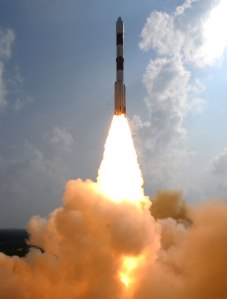 Today India launched its first rocket to Mars. The Mars Orbiter Mission, also known as Mangalyaan, aims to reach Mars orbit by September 2014. I know, I know, still a long way to go before sending a manned mission and discovering little green men, but I still cheer at the news. ISRO can be right proud today. Only the United States, Europe and Russia have succeeded in sending probes that have orbited or landed on Mars. In fact, 23 out of 40 missions to Mars have failed. So here’s hoping Mangalyaan fulfills its destiny and meets Mars next year. Mangalyaan carries five scientific payloads to observe the Martian surface, atmosphere and exosphere. You can read all about it here.
Today India launched its first rocket to Mars. The Mars Orbiter Mission, also known as Mangalyaan, aims to reach Mars orbit by September 2014. I know, I know, still a long way to go before sending a manned mission and discovering little green men, but I still cheer at the news. ISRO can be right proud today. Only the United States, Europe and Russia have succeeded in sending probes that have orbited or landed on Mars. In fact, 23 out of 40 missions to Mars have failed. So here’s hoping Mangalyaan fulfills its destiny and meets Mars next year. Mangalyaan carries five scientific payloads to observe the Martian surface, atmosphere and exosphere. You can read all about it here.
The Red Planet has captured the imagination of writers, philosophers and astronomers since the time humans looked up at the night sky and wondered what was out there. It is the most ‘earth-like’ planet of our solar system. Venus might be closer to us, but Mars is more transparent, more hospitable. ‘Hospitable’ being a relative term here: with an average temperature of -63 C, high radiation and a miserably thin atmosphere, we aren’t building resorts there any time soon. But one day we might be. I live in hope.
NASA is sending its own MAVEN to Mars later this month – another unmanned orbiter. All this is supposed to pave the way for eventual human exploration. Evidently, while hundreds of thousands of people are willing to make a one-way trip to Mars (Sign up at: http://applicants.mars-one.com/), NASA actually wants to ensure that people can come back. And here is the tricky part of the whole affair. It would take a much heavier spacecraft, much more fuel and way more money.
Mars Direct is one relatively cost-effective way of tackling this problem. It envisions launching two spacecraft – the first unmanned craft will land on Mars and convert chemicals into fuels. The second craft will carry the astronauts, secure in the knowledge that a return craft with sufficient fuel awaits them on Mars.
Check out Mars One – an organization dedicated to establishing a permanent human colony on Mars in ten years time. You may even want to join them! The Red Planet still captures our minds, our dreams. No wonder so many famous science fiction novels are set in or about Mars. Some of my favorites:
The Martian Chronicles by Ray Bradbury
The War of the Worlds by H.G. Wells
The Mars Trilogy by Kim Stanley Robinson
Red Planet by Robert A. Heinlein
Would you take a one-way ticket to Mars?

Bravo to India …
KSR’s Mars trilogy blew my mind when I first read it. I’m probably due for a re-read. Thanks for the reminder.
… I think that colonisation of our solar system needs to be based on the ‘one-way ticket’ model, at least until we have a power source that can reduce travel time from years to weeks.
LikeLike
I agree. First robotic spacecraft that will set up Habitat Modules, and then the humans. I’d totally volunteer!
LikeLike
One of the things I found amazing about this mission was it’s cost. In fact, if I have it correct, the total cost was only about 75% of what it took to produce the film “Gravity.” Amazing. It’s also nice to see India start to assert its place in the world. For far too long it’s people have had to travel to other parts of the world to be recognized now, though, it’s starting to be cool to be FROM India again.
LikeLike
Yes, it’s a pretty low cost mission – USD 72 million compared to NASA’s 671 million for MAVEN, which has fairly similar goals. Plus India’s space program has very practical applications – communications, cartography, water/land management, disaster management, metereology – the list is endless.
LikeLike
Do you think a third world country can afford a mission to Mars? Shouldn’t they spend the money on education and health?
LikeLike
So because a country has social and economic problems, it should not have scientific aspirations? This reminds me of what the Economist said: ‘What if the 16,000 scientists and engineers now working on space development were deployed instead to fix rotten sanitation?’ – as if it’s either sanitation or space. We cannot have both! This is a very Western attitude and you will not find many ‘third world country’ inhabitants who share it with you.
LikeLike